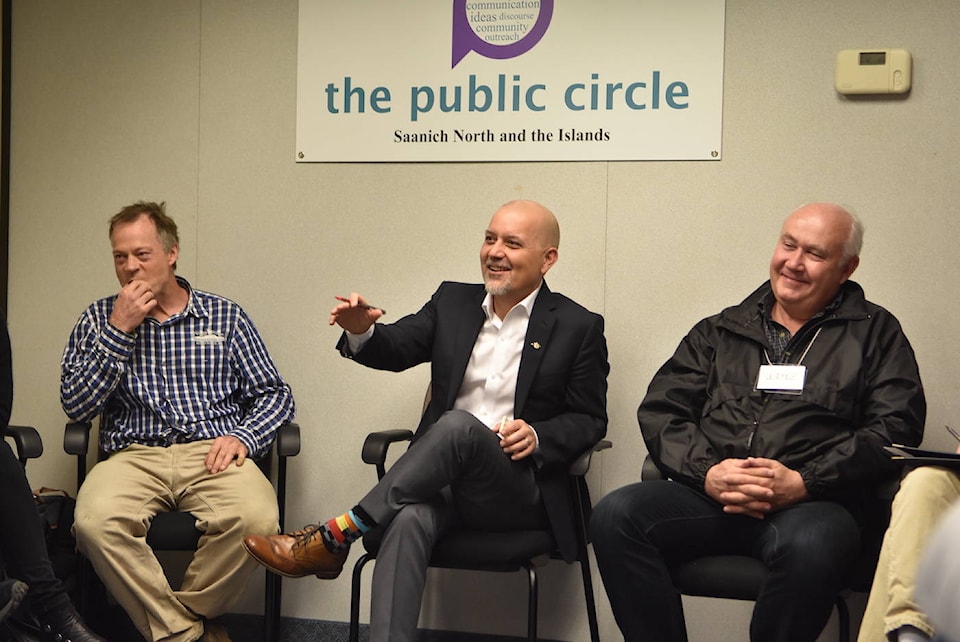Agriculture on the Saanich Peninsula is “a growing concern,” quipped Adam Olsen, MLA for Saanich North and the Islands, at the start of another community dialogue in his Beacon Ave. constituency office. While marijuana greenhouses on agricultural land was a recurring theme, some participants said growing in the soil had its own problems, and that the Agricultural Land Commission Act required many reforms.
The meeting was attended by concerned residents, Mayor Ryan Windsor of Central Saanich and Shawn Galbraith, the CEO of Evergreen Medicinal Supply — which wants to build marijuana greenhouses on the former Stanhope dairy farm.
On the greenhouse issue, attendees were concerned about the use of Grade 1 agricultural soil for greenhouses (farm soil in the province is graded on a scale of 1-7, with Grade 1 being the best, and Grade 7 being unsuitable for all grazing and arable agriculture).
Ty James, of West Coast Micro Greens, said not all greenhouses needed to have concrete floors. Caterpillar tunnels with walls of plastic film can be placed over soil, but that is not appropriate for propagating plant starts or cultivating hydroponics, for example, which is an established use of ALR land.
Greenhouses tend to be for higher-value crops like peppers and tomatoes, said James. Because Island weather is not suited for year-round growing, James said greenhouses are a necessity if people want more locally grown food (with or without concrete pads). Olsen said the ALC’s primary mandate is to protect agricultural land; food security is only a secondary mandate.
James said no-till farming was a promising. It uses minimal tillage to preserve soil ecology to grow more intensively on smaller plots of land. He suggested that could be the way for the old Sandown property.
Some speakers criticized current ALC regulations for being contradictory to some agricultural activities. For instance, to build a processing facility for crops, 50 per cent of the processed food must be grown on that land. For that reason, James said it only made economic sense on “a huge plot of land, like 100 acres, not two.” James said because value-added products (jams, sauces, etc.) could be sold for much higher prices than unprocessed fruits or vegetables, farmers should be able to reap those benefits.
James said he saw butternut squash on a store shelf for $1.89 a pound, but spiralized squash (a relatively simple form of processing) sold for over three times that. He said thousands of pounds of pumpkins at Michell’s Farm also go unsold after Halloween because they are not the right size for retailers. James said the pumpkins could be turned into powder to make syrup for pumpkin spice lattes, but there is no space to process them.
Other speakers identified farm worker housing as a concern, because while there is significant public attention on “mega-mansions” on ALR land, they said there are many restrictions on building farm worker housing on farmland. It would be cost prohibitive to place them in residential areas.
Tiffany Joseph, who is from Tsartlip, said people should broaden their perspective on what can be considered agriculture. She said willow can be grown for fence panelling and baskets, and nettle can make wool. Willow baskets are sold at Michael’s craft stores, so there is a market for it, and these products do not require fertilizers and pesticides.
Olsen picked up where Joseph left off, saying there was a misconception that local First Nations “stumbled upon” food in the area, but in reality, “if we were to use modern terms, agriculture has been going on for a long time.” Deer, camas, and fish were harvested in very deliberate ways. Olsen pointed out that open field agriculture can be very destructive to the watersheds. There are minimal regulations on pesticides, and creeks can be modified for improved drainage, all of which affects the environment.
B.C. Minister of Agriculture Lana Popham is currently engaging in a public engagement about the ALR, so Olsen encouraged members of the meeting to respond to the engagement to make their concerns known. The consultation closes at the end of the month.
“I hope we get this right, because this might be the only time in a generation that we have,” said Windsor.
To provide feedback to the Minister of Agriculture on the future of the Agricultural Land Reserve, visit engage.gov.bc.ca/agriculturallandreserve/
